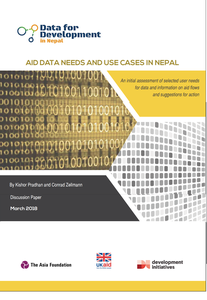Discussion paper: Aid data needs in Nepal
This is a re-post from Conrad Zellmann at Development Initiatives who co-authored Aid data needs and use cases in Nepal.

Recent years have seen increasing efforts, both locally in Nepal and internationally, to improve how data and information about aid flows is collected and shared. The government of Nepal, supported by development partners, has established the Aid Management Platform (AMP) and launched its public website. Several other platforms and initiatives have been put in place by various actors with the aim of providing aid-related and humanitarian information, in particular following the 2015 earthquake in Nepal. This reflects a growing demand for increased production, sharing and use of data to meet development aims, as well as improved transparency and accountability.Internationally, there has also been an increase in the availability and quality of data. The International Aid Transparency Initiative (IATI) now has more than 600 bilateral, multilateral, non-government and private sector development partners publishing data to its standard. The Data Revolution has brought the role of data in meeting and monitoring the Sustainable Development Goals (SDGs) to the fore. What is less clear, is the extent to which aid data is being used, by whom and for what purpose, and it is this that the discussion paper seeks to investigate for the specific case of aid information use in one country.This discussion paper highlights information needs of different stakeholder groups to assist user-centred approaches to providing data on aid finance, considers the potential role of data published to the IATI Standard in this context, and builds interest in increased use of data on aid finance among key stakeholder groups.
Key findings
- Many stakeholders share common interests and needs with regard to financial information on aid. There is a shared motivation to understand how aid is allocated, spent and what results it contributes to.
- There is a demand for more analytical information, in particular on needs, resources and results of development interventions; aid in relation to national SDGs and other indicators; and aid in relation to domestic resources.
- Despite the increase in availability of aid data from national and international sources and platforms, in practice stakeholders rely strongly on written reports, organisational websites and their interpersonal networks to access and use the information they need.
- Greater efforts are needed to increase the awareness of aid data availability from the AMP and IATI, and to engage proactively with different user groups and intermediaries who can support the translation of data into actionable analysis. Ideally this would build on existing information and communication preferences, and coordination fora to enhance these with better data and analysis.
- For this, openness of aid data and its interoperability with other sources of official and administrative data is critical.

This discussion paper was co-authored by Conrad Zellmann of DI and Kishor Pradhan, an independent consultant. It was undertaken under the ‘Improving Sharing and Use of (open) Data as Evidence for Development in Nepal’ programme, implemented by The Asia Foundation in partnership with Development Initiatives with funding from the UK’s Department for International Development (DFID). The programme is part of the wider DFID funded ‘Evidence for Development’ programme that works to strengthen the government of Nepal’s capacity to generate and use data effectively.